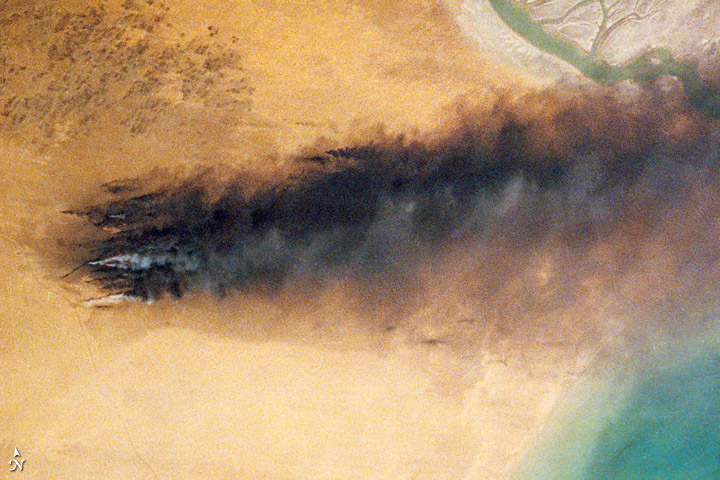
Best New Year’s gift ever! EarthSky moon calendar for 2019
This article is republished with permission from GlacierHub. This post was written by Nabilah Islam.
Black carbon is an atmospheric pollutant. The very small particles are formed through the combustion of fossil fuels, biofuel and biomass, and settle from the air slowly. Also known as soot, this material absorbs solar radiation, trapping heat in the atmosphere and contributing heavily to global warming. A study published September 28, 2018, in Atmospheric Chemistry and Physics traces black carbon transport from the Gulf War Kuwait oil fires of January to November 1991 to the atmosphere and ice core at Muztagh Ata Mountain on the remote northern Tibetan plateau. Researchers examine the effects of this material on glacier melt at the plateau, considered the Water Tower of Asia, which could impact runoff to the major rivers of Asia.
Black carbon in the air absorbs and scatters solar radiation, impacting the radiative balance. There is also a more direct affect on the ice, contributing to greater melting. Researchers identified past ice core analyses in the Swiss Alps, Antarctica and Greenland. They recognized the great value of ice cores in providing historical black carbon emissions, distribution and regional aerosol transport. The importance of a historical context in current black carbon deposition guided the methodology for this study. The climate in this region is very sensitive to warming, so any small change in the region’s warming mechanisms could have large impacts on the glaciers and the hydrological cycle.

The black carbon in the ice core at Muztagh Ata Mountain was analyzed along with the atmospheric composition of CO2 percentage at the site. Researchers relied on a chemical transport model used to quantify the global budget of trace gases and aerosol particles, and to study movement by wind in the atmosphere and chemical transformations and removals. They were able to trace different source regions through chemical compositions and measured the temporal variations in black carbon concentration. They also analyzed the long-term trend since the early 1990s of black carbon deposition. Muztagh Ata Mountain is downwind from several source regions: Central Asia, Europe, the Persian Gulf and South Asia. These regions were expected to have the greatest contributions to black carbon accumulation at the mountain site.
Results of the study suggested an unusually strong spike in black carbon during the period from 1991 to 1992. Researchers hypothesized that the massive Kuwait fires at the end of the first Gulf War in 1991 caused this peak in concentration. At the time, Iraqi forces set fire to over 650 oil wells in Kuwait. An estimated 1.5 million barrels of crude oil were released into the environment, making it the largest oil spill in history. Black smoke plumes were monitored by satellites and observed to spread over 2,500 kilometers [1,553 miles], with some material eventually reaching the Muztagh Ata Mountain.
The chemical transportation model was used to simulate the atmospheric black carbon concentrations and depositions for the period before and after the fires, from 1984 to 1994. The simulation used data for anthropogenic black carbon emissions for the non-Kuwait fire periods and enhanced emissions by 50 times from January to November 1991 to represent the Kuwait fires. Winds by the fire region move in the northern and northwestern direction, and the highest concentration appeared to have been transported westward toward the mountain. This, as well as the historical context, supports the hypothesis that the Kuwait oil fires contributed to greater black carbon on Muztagh Ata.

The high black carbon concentration from this event also had significant effects on the glacier’s snow cover and radiative forcing, which is the balance of incoming solar heat to outgoing heat. Researchers found the radiative forcing increase was about two to five times higher than the normal period before and after the Kuwait oil fires. Also, the black carbon on the upper portion of the glacier would have been covered with fresh snow, but might have stayed longer, uncovered, on the ablation zone. These processes resulted in a significant increase of melting from the glacier since the time of the fires, strongly impacting the hydrologic cycle and water resources in surrounding regions.
Philip K. Hopke, researcher of environmental chemistry and adjunct professor at the University of Rochester School of Medicine and Dentistry, told GlacierHub about the impacts of black carbon on the Tibetan Plateau. Hopke identifies water supply to be the main issue, considering the glaciers here feed into many major rivers such as the Ganges, Yangtze, and Indus rivers. Loss of glaciers and their water feed could lead to disastrous shortages and conflict over control of resources. He added:
Enhanced melt by rising temperatures is already an issue and exacerbation by deposited black carbon would make things worse.
Hopke also mentions that in some ways, warfare might improve local air quality through reduced economic activity and forced evacuations. Additionally, it would take a major conflict to produce sufficient emissions to have such widespread effects. Fortunately, there are no uncontrolled fires today, though it is important to recognize the risks of war and long-distance impacts. The situation in Syria at present, for example, remains uncertain, as well as the situation in northern Iraq, a country that is home to some of the world’s largest oil reserves, which may be at risk.
Bottom line: A study traces black carbon from the massive Kuwait oil fires at the end of the Gulf War in 1991 to ice in northern Tibet. Researchers say this material could affect ice melt at the Tibetan plateau, which is known as the Water Tower of Asia.
Source: Black carbon (BC) in a northern Tibetan mountain: effect of Kuwait fires on glaciers











